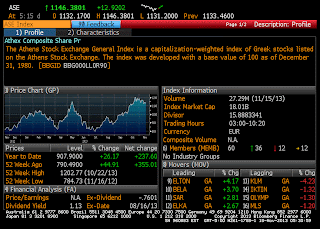(Photo of the Greek Stock Market back in the days when its home was still in Sofokleous 10)
When talking about the Athens stock exchange the majority of the media and a lot of market participants quote the ASE Index (Bloomberg) which also goes by the ticker GD or in Greek sites as ΓΔ.
The ASE index is a capitalization weighed index that consists of 60 names in the main market of the Athens stocks Exchange.
There for the ASE index is used by media and many participants of the market in order to monitor the overall behavior and trend of the Greek Market.
Where does the problem start ?
The ASE index is not tradable index (so no futures to hedge your position exist) and there are numerous stocks that are as liquid some days as the depth in a spoon of water. This creates extra noise, and in the recent periods of low liquidity we have experienced the last few months (especially during the summer) could generate a lot of false signals and also could be easily manipulated (during the summer the total trading activity was more or less 30 mio euro).
The FTASE index on the other hand is a traded index that consists of the 25 most traded and most liquid stocks in the Athens stock exchange (Of course the most liquid is again a topic of discussion if one is used in US markets, I consider even some of the elements of FTASE to have limited liquidity during slow trading periods and therefore I would check twice the average # of shares in even some names in the FTASE index) .
The 25 stocks of the FTASE index would (on an average day) pretty much sum up to 90% of the total volume traded in the Greek market giving you a representation of the market action that would qualify reliable ( as reliable markets can be these days ).
Given that I don't want to bore you to death with my mumbling, this summer when ASE was making new lows FTASE was double bottoming and that is what kept me in the market. This is shown in the following graphs
.jpg)




No comments:
Post a Comment